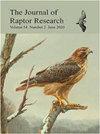美国红隼与欧洲椋鸟争夺宾夕法尼亚州东部的巢箱
IF 1.2
4区 生物学
Q2 ORNITHOLOGY
引用次数: 1
摘要
美国红隼(Falco sparverius)在其北美东部的大部分活动范围内一直在稳步下降,这种下降的原因仍然相对未知。作为一种洞巢鸟类,美洲红隼经常与其他洞巢鸟类竞争巢箱,如入侵和大量的欧洲椋鸟(Sturnus vulgaris)。欧洲椋鸟在筑巢地点的存在与美国红隼的占有和筑巢成功之间的关系尚未得到充分研究。本文分析了1992年至2021年美国宾夕法尼亚州东部地区红隼巢箱的监测数据,以确定美国红隼和竞争对手的占用率变化,并研究了巢箱竞争与美国红隼筑巢参数之间的关系。我们发现,在研究期间,美国红隼的占用率下降,而欧洲椋鸟的占用率上升。其他占据巢箱的物种(小型哺乳动物、雀形目动物、猫头鹰和蛇)没有明显的占据趋势。平均每年有21%的巢箱空置,在同一繁殖季节,美国红隼和竞争对手都使用了7%的巢箱。这些竞争者的存在与美国红隼的占用率、窝卵大小、雏鸟数量和整体筑巢成功率呈负相关。具体来说,当欧洲椋鸟在同一繁殖季节使用相同的巢箱时,筑巢成功率下降了26%。近年来,美国红隼的筑巢率有所下降,平均雏鸟数、雏鸟数和筑巢成功率均有所下降,而平均窝数保持不变。研究结果表明,美国红隼在宾夕法尼亚州东部的筑巢参数与繁殖季节对巢箱的竞争呈负相关。在这个研究区域,欧洲椋鸟和美国红隼的占领趋势相反,加上美国红隼巢穴的生产力下降,人们对宾夕法尼亚州东部这种猛禽物种的未来感到担忧。本文章由计算机程序翻译,如有差异,请以英文原文为准。
American Kestrels Compete with European Starlings over Nest Boxes in Eastern Pennsylvania
The American Kestrel (Falco sparverius) has been steadily declining throughout most of its eastern North American range, and the cause of this decline is still relatively unknown. As a cavity nesting species, the American Kestrel often competes with other cavity nesters such as the invasive and abundant European Starling (Sturnus vulgaris) over nest boxes. The relationship between European Starling presence at nesting sites and American Kestrel occupancy and nesting success is understudied. We analyzed data from nest boxes monitored in eastern Pennsylvania, USA, from 1992 to 2021 to identify changes in occupancy of American Kestrels and competitors, and to examine the relationship between competition at nest boxes and American Kestrel nesting parameters. We found that American Kestrel occupancy decreased while European Starling occupancy increased over the study period. All other species occupying nest boxes (small mammals, passerines, owls, and snakes) showed no significant occupancy trends. On average 21% of nest boxes remained unoccupied annually, and 7% of occupied nest boxes were used by both American Kestrels and competitors in the same breeding season. The presence of these competitors had negative associations with American Kestrel occupancy, clutch size, number of fledglings produced, and overall nesting success. Specifically, the rate of nesting success decreased by 26% when European Starlings used the same nest box within the same breeding season. In recent years, nesting productivity of American Kestrels has decreased, with the average number of nestlings, fledglings, and nesting success rate all declining, while the average clutch size remained constant. Our results suggest that American Kestrel nesting parameters in eastern Pennsylvania are negatively associated with competition for nest boxes during the breeding season. The opposing trends in occupancy for the European Starling and the American Kestrel in this study area coupled with the declining productivity of American Kestrel nests raise concerns over the future of this raptor species in eastern Pennsylvania.
求助全文
通过发布文献求助,成功后即可免费获取论文全文。
去求助
来源期刊

Journal of Raptor Research
生物-鸟类学
CiteScore
2.30
自引率
17.60%
发文量
61
审稿时长
>12 weeks
期刊介绍:
The Journal of Raptor Research (JRR) is an international scientific journal dedicated entirely to the dissemination of information about birds of prey. Established in 1967, JRR has published peer-reviewed research on raptor ecology, behavior, life history, conservation, and techniques. JRR is available quarterly to members in electronic and paper format.
 求助内容:
求助内容: 应助结果提醒方式:
应助结果提醒方式:


